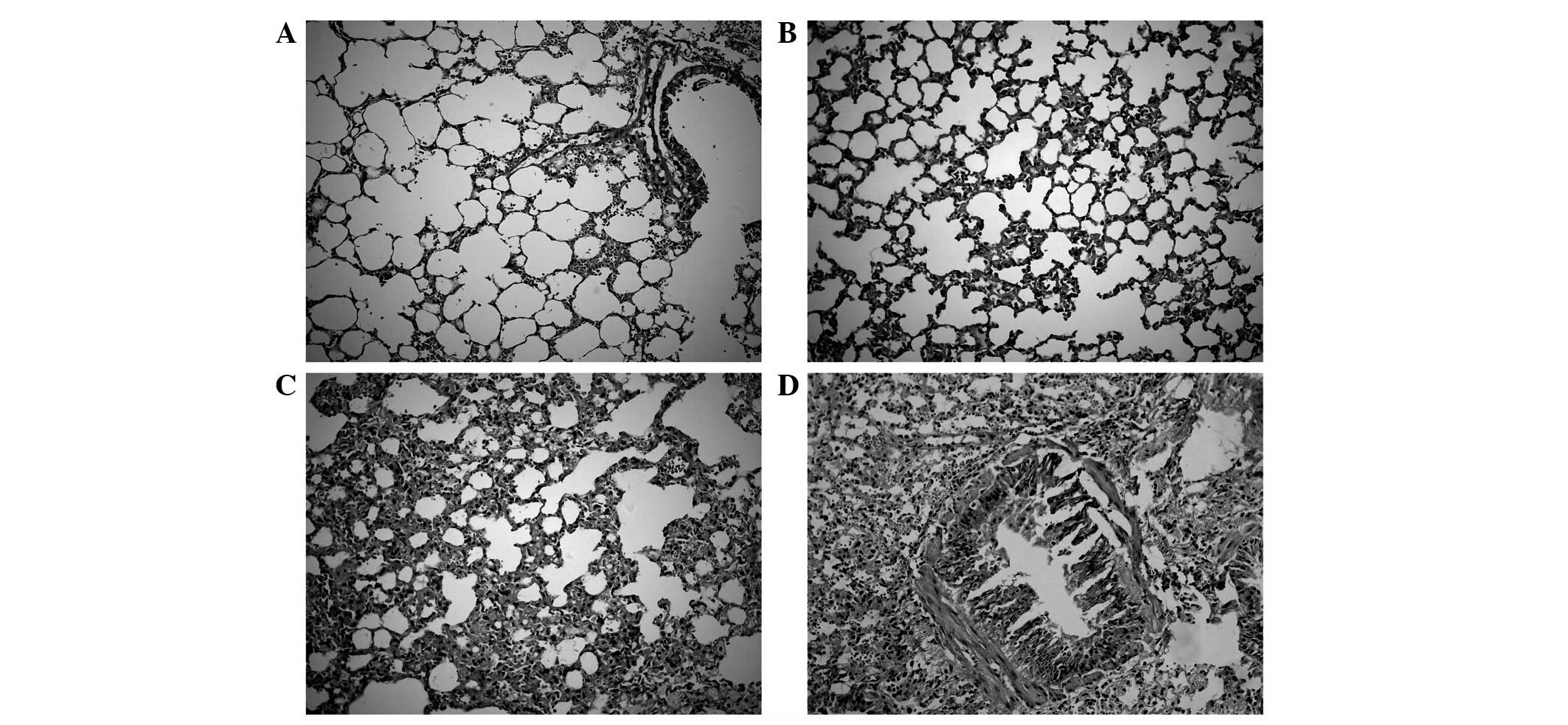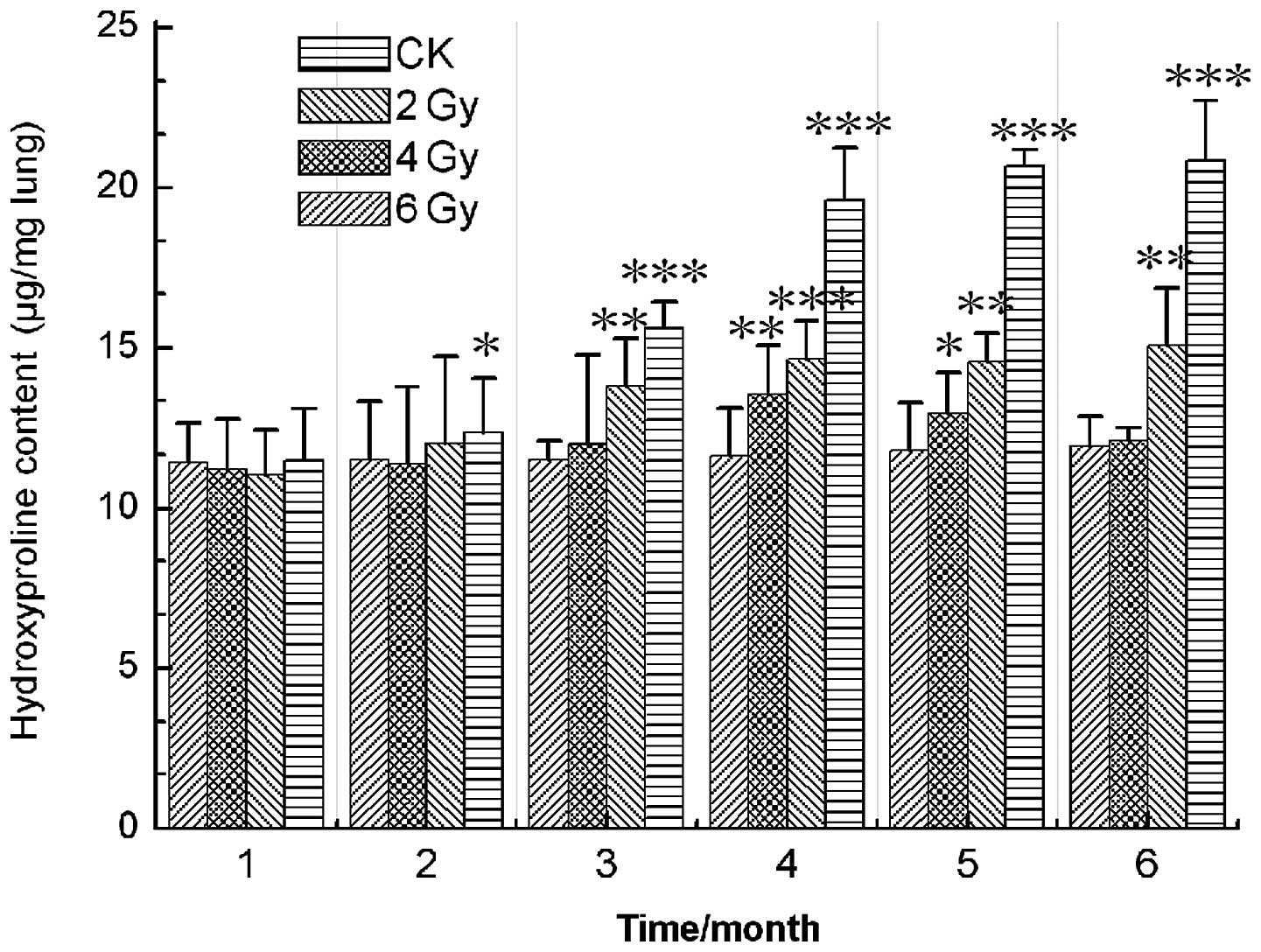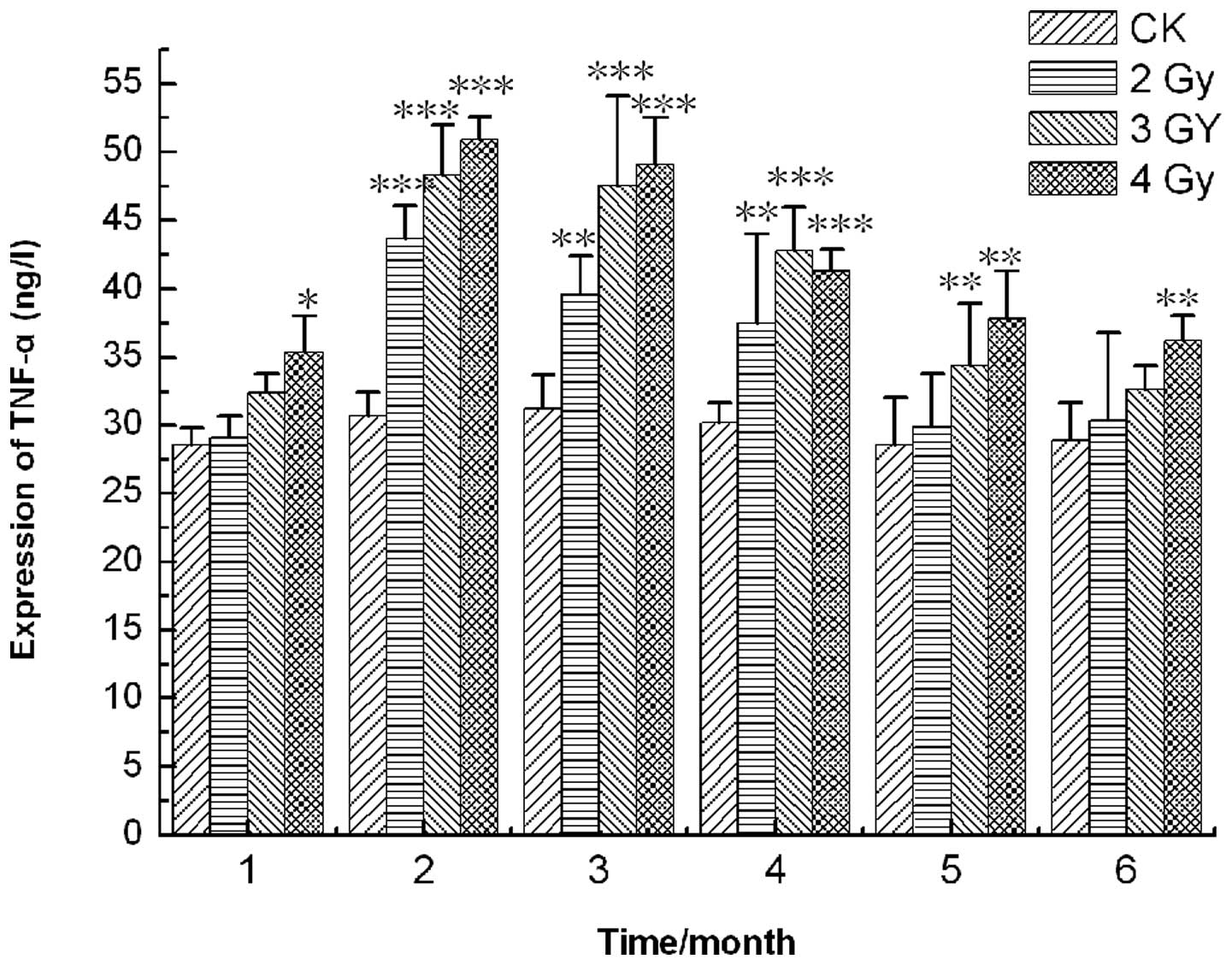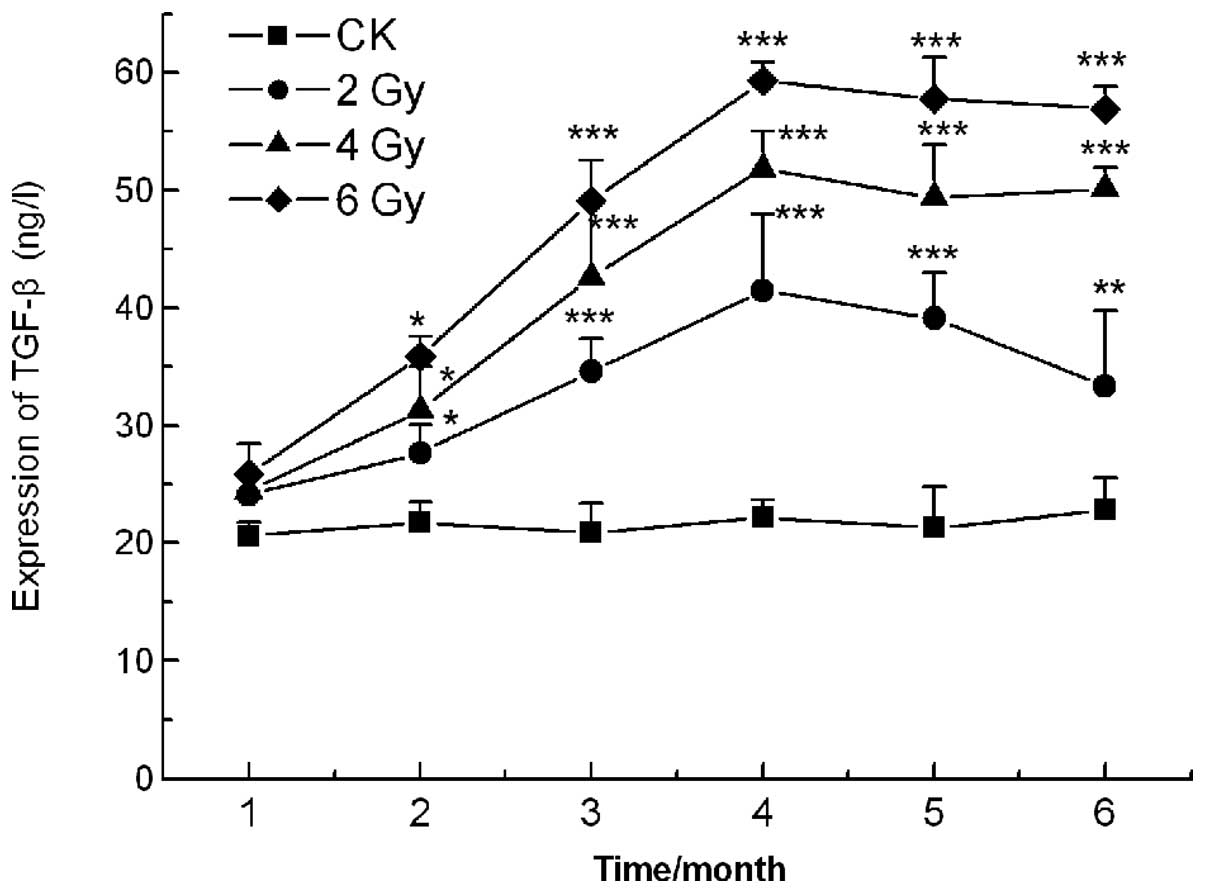|
1.
|
Vujaskovic Z, Marks LB and Anscher MS: The
physical parameters and molecular events associated with
radiation-induced lung toxicity. Semin Radiat Oncol. 10:296–307.
2000. View Article : Google Scholar : PubMed/NCBI
|
|
2.
|
Noth I and Martinez FJ: Recent advances in
idiopathic pulmonary fibrosis. Chest. 132:637–650. 2007. View Article : Google Scholar
|
|
3.
|
Du Bois RM: Idiopathic pulmonary fibrosis.
Annu Rev Med. 44:441–450. 1993.
|
|
4.
|
Lingos TI, Recht A, Vicini F, Abner A,
Silver B and Harris JR: Radiation pneumonitis in breast cancer
patients treated with conservative surgery and radiation therapy.
Int J Radiat Oncol Biol Phys. 21:355–360. 1991. View Article : Google Scholar : PubMed/NCBI
|
|
5.
|
Wagner GR: Asbestosis and silicosis.
Lancet. 349:1311–1315. 1997. View Article : Google Scholar : PubMed/NCBI
|
|
6.
|
Tyurina YY, Tyurin VA, Kapralova VI,
Wasserloos K, et al: Oxidative lipidomics of γ-radiation-induced
lung injury: Mass spectrometric characterization of cardiolipin and
phosphatidylserine peroxidation. Radiat Res. 175:610–621. 2011.
|
|
7.
|
Margetts PJ, Bonniaud P, Liu L, et al:
Transient over-expression of TGF-β1 induces epithelial mesenchymal
transition in the rodent peritoneum. J Am Soc Nephrol. 16:425–436.
2005.
|
|
8.
|
Martinez Flórez S, Gutiérrez Fernandéz B,
Sánchez-Campos S, González Gallego J and Tuñón MJ: Quercetin
attenuates nuclear factor-kappa activation and nitric oxide
production in interleukin-1 beta-activated rat hepatocytes. J Nutr.
135:1359–1365. 2005.PubMed/NCBI
|
|
9.
|
Mu E, Liu XJ, Chen S, et al: Changes in
factor VII-activating protease in a bleomycin-induced lung injury
rat model and its influence on human pulmonary fibroblasts in
vitro. Int J Mol Med. 26:549–555. 2010.PubMed/NCBI
|
|
10.
|
Yara S, Kawakami K, Kudeken N, et al: FTS
reduces bleomycin-induced cytokine and chemokine production and
inhibits pulmonary fibrosis in mice. Clin Exp Immunol. 124:77–85.
2001. View Article : Google Scholar : PubMed/NCBI
|
|
11.
|
Liu R, Ahmed KM, Nantajit D, et al:
Therapeutic effects of α-lipoic acid on bleomycin induced pulmonary
fibrosis in rats. Int J Mol Med. 19:865–873. 2007.
|
|
12.
|
Armutcu F, Çabuk M, Gurel A, Atmaca H and
Kart L: Caffeic acid phenethyl ester and vitamin E moderates IL-1β
and IL-6 in bleomycin-induced pulmonary fibrosis in rats. Pestic
Biochem Physiol. 88:209–212. 2007.
|
|
13.
|
Liu JF, Wang X, Wang F, Teng L and Cao J:
Attenuation effects of heparin superoxide dismutase conjugate on
bleomycin-induced lung fibrosis in vivo and radiation-induced
inflammatory cytokine expression in vitro. Biomed Pharmacother.
63:484–491. 2009. View Article : Google Scholar
|
|
14.
|
Tomita M, Okuyama T, Katsuyama H, et al:
Gene expression in rat lungs during early response to
paraquat-induced oxidative stress. Int J Mol Med. 17:37–44.
2006.PubMed/NCBI
|
|
15.
|
Hagimoto N, Kuwano K, Inoshima I, et al:
TGF-beta 1 as an enhancer of Fas-mediated apoptosis of lung
epithelial cells. J Immunol. 168:6470–6478. 2002. View Article : Google Scholar : PubMed/NCBI
|
|
16.
|
Dong XC, Li WJ, Liu QF, et al: The
influence of carbon ion irradiation on sweet sorghum seeds. Nucl
Instrum Methods Phys Res B. 266:123–126. 2008. View Article : Google Scholar
|
|
17.
|
Ritter MA, Cleaver JE and Tobias CA:
High-LET radiations induce a large proportion of non-rejoining DNA
breaks. Nature. 266:653–655. 1977. View
Article : Google Scholar : PubMed/NCBI
|
|
18.
|
Sekine E, Okada M, Matsufuji N, Yu D,
Furusawa Y and Okayasu R: High LET heavy ion radiation induces
lower numbers of initial chromosome breaks with minimal repair than
low LET radiation in normal human cells. Mutat Res. 652:95–101.
2008. View Article : Google Scholar
|
|
19.
|
Zhang H, Li S, Wang XH, et al: Results of
carbon ion radiotherapy for skin carcinomas in 45 patients. Br J
Dermatol. 166:1100–1106. 2012. View Article : Google Scholar : PubMed/NCBI
|
|
20.
|
Wu ZH, Zhang H, Wang XY, et al: Protective
effects of melatonin against 12C6+ beam
irradiation-induced oxidative stress and DNA injury in the mouse
brain. Adv Space Res. 49:196–203. 2012.
|
|
21.
|
Zhou G, Kawata T, Furusawa Y, et al:
Protective effects of melatonin against low- and high-LET
irradiation. J Radiat Res. 47:175–181. 2006. View Article : Google Scholar : PubMed/NCBI
|
|
22.
|
Zhang H, Zhao W, Wang Y, et al: Induction
of cytogenetic adaptive response in spermatogonia and spermatocytes
by pre-exposure of mouse testis to low-dose
12C6+ ions. Mutat Res. 653:109–112. 2008.
View Article : Google Scholar : PubMed/NCBI
|
|
23.
|
Liu Y, Zhang H, Zhang L, Zhang X, Xie Y
and Zhao W: Melatonin modulates acute testicular damage induced by
carbon ions in mice. Pharmazie. 64:685–689. 2009.PubMed/NCBI
|
|
24.
|
Stone HB, Coleman CN, Anscher MS and
McBride WH: Effects of radiation on normal tissue: consequences and
mechanisms. Lancet Oncol. 4:529–536. 2003. View Article : Google Scholar : PubMed/NCBI
|
|
25.
|
Finkelstein JN, Johnston CJ, Baggs R and
Rubin P: Early alterations in extracellular matrix and transforming
growth factor beta gene expression in mouse lung indicative of late
radiation fibrosis. Int J Radiat Oncol Biol Phys. 28:621–631. 1994.
View Article : Google Scholar : PubMed/NCBI
|
|
26.
|
Rodeman HP and Bamberg M: Cellular basis
of radiation-induced fibrosis. Radiother Oncol. 35:83–90. 1995.
View Article : Google Scholar : PubMed/NCBI
|
|
27.
|
Rubin P, Johnston CJ, Williams JP,
McDonald S and Finkelstein JN: A perpetual cascade of cytokines
post irradiation leads to pulmonary fibrosis. Int J Radiat Oncol
Biol Phys. 33:99–109. 1995. View Article : Google Scholar : PubMed/NCBI
|
|
28.
|
Anscher MS, Kong FM, Andrews K, et al:
Plasma transforming growth factor beta1 as a predictor of radiation
pneumonitis. Int J Radiat Oncol Biol Phys. 41:1029–1035. 1998.
View Article : Google Scholar : PubMed/NCBI
|
|
29.
|
Fu XL, Huang H, Bentel G, et al:
Predicting the risk of symptomatic radiation-induced lung injury
using both the physical and biologic parameters V30 and
transforming growth factor β. Int J Radiat Oncol Biol Phys.
50:899–908. 2001. View Article : Google Scholar : PubMed/NCBI
|
|
30.
|
Chen Y, Williams J, Ding I, et al:
Radiation pneumonitis and early circulatory cytokine markers. Semin
Radiat Oncol. 12(Suppl 1): 26–33. 2002. View Article : Google Scholar : PubMed/NCBI
|
|
31.
|
Broekelmann TJ, Limper AH, Colby TV and
Mcdonald JA: Transforming growth factor beta 1 is present at sites
of extra-cellular matrix gene expression in human pulmonary
fibrosis. Proc Natl Acad Sci USA. 88:6642–6646. 1991. View Article : Google Scholar : PubMed/NCBI
|
|
32.
|
Lee JC, Kinniry PA, Arguiri E, Serota M,
Kanterakis S, Chatterjee S, et al: Dietary curcumin increases
antioxidant defenses in lung, ameliorates radiation-induced
pulmonary fibrosis, and improves survival in mice. Radiat Res.
173:590–601. 2010. View Article : Google Scholar
|
|
33.
|
Dotor J, López-Vázquez AB, Lasarte JJ, et
al: Identification of peptide inhibitors of transforming growth
factor beta 1 using a phage-displayed peptide library. Cytokine.
39:106–115. 2007. View Article : Google Scholar
|
|
34.
|
Poli G and Parola M: Oxidative damage and
fibrogenesis. Free Radic Biol Med. 22:287–305. 1997. View Article : Google Scholar : PubMed/NCBI
|
|
35.
|
Harroon ZA, Raleigh JA, Greenberg CS and
Dewhirst MW: Early wound healing exhibits cytokine surge without
evidence of hypoxia. Ann Surg. 231:137–147. 2000. View Article : Google Scholar : PubMed/NCBI
|
|
36.
|
Vujaskovic Z, Anscher MS, Feng QF, et al:
Radiation-induced hypoxia may perpetuate late normal tissue injury.
Int J Radiat Onco Biol Phys. 50:851–855. 2001. View Article : Google Scholar : PubMed/NCBI
|
|
37.
|
Kang SK, Rabbani ZN, Folz RJ, et al:
Overexpression of extracellular superoxide dismutase protects mice
from radiation-induced lung injury. Int J Radiat Oncol Biol Phys.
57:1056–1066. 2003. View Article : Google Scholar : PubMed/NCBI
|



















